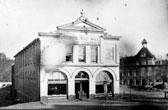|
From the Cleveland County Centennial Celebration Shelby Star 1940
Article by Jno. F. Schenck, Sr.
About 25 years after the Civil War, recovery, in economic conditions, accompanied by a continuation of the untrammeled American freedom, was sufficient to justify and encourage a rather rapid industrial growth in the South.
It resulted in the promotion and construction of many up-to-date textile factories in Cleveland County, a number of which are now out-standing and well-known because of the variety, the excellence and novelty of production.
Heroic Struggles
But the purpose of this article is to afford a glimpse of only one or two of Cleveland County's pioneer textile developments.
In such a narrative, we will be telling the story of an ambitious and heroic struggle against adversity--a story which will, to a great extent, be applicable to most of the other southern textile developments which were undertaken early after the close of the Civil War.
These pioneer textile developments were burdened with two severe handicaps--the greatest being poverty.
In that period our county, and all the counties of the South, were financially prostrate; suffering from a depression, by far, the longest and most discouraging that has ever afflicted our people.
During those tragically gloomy days for the South, there was no such thing as federal relief.
There was not even federal sympathy.
Other Handicaps
Another handicap was the adverse propaganda, released by northern competition, to the effect that climactic conditions and lack of competent labor in the South, made it impossible to ever successfully manufacture textiles there.
However, in spite of these handicaps, there were a few enterprising southern pioneers, who, early after the Civil War, "broke the ice" and dared to embark into the business of converting their neighbors' cotton into yarn, thread, and cloth.
Within a few years it was demonstrated by these textile pioneers that the climate in the southern states was ideal for manufacturing cotton successfully, and that the cheaper labor in the South was as competent as that in the North, and much more reliable and loyal.
Two pioneer cotton factories in Cleveland County began operations very nearly together.
First Mill in 1871
They were Double Shoals Cotton Mill, and Cleveland Cotton Mills.
The former was located about nine miles north of Shelby, on First Broad River. It was constructed about the year 1871. It was owned by Abernethy Jackson. It consisted of a small wooden building, equipped with second-hand machinery, and driven by an old-fashioned "overshot" water wheel.
Later, Double Shoals cotton Mills were acquired by a E. A. Morgan, who greatly enlarged the plant housing it in a up-to-date brick building, and improved it in many ways.
Mr. Morgan, and his son, Fred, operated this plant quite successfully, for many years, mainly in the production of a nice grade of wrapping twine. The plant is yet in operation.
Second in 1873
The other pioneer cotton factory in Cleveland County (Cleveland Cotton Mills) was situated at a place known as "Cleveland Mills."
It was located about five miles north of Double Shoals on Knob Creek, near to where the creek empties into First Broad River.
It was a small wooden two-story building filled with second-hand machinery.
In the year 1873 it was promoted, constructed, and operated by Major H. F. Schenck.
The product of this plant attracted the attention of a very successful northern yarn merchant, by name of James E. Reynolds.
Mr. Reynolds got in touch with Major Schenck by correspondence and this led to a visit by Mr. Reynolds.
The meeting of this shrewd, wealthy and ruggedly honest Yankee with an equally honest ex-soldier and officer of the Confederate Army, was the beginning of a life-long friendship which was beautiful; and of a business arrangement which, for many years, was mutually pleasant and profitable.
Soon after his first visit, Mr. Reynolds offered to become associated with Major Schenck, and construct and operate a larger and up-to-date factory.
Moved and enlarged
The proposition was accepted, and the proposed factory was built in 1888 on First Broad River, about two miles south of the older plant.
Soon after this, all of the worthwhile equipment of the old factory was moved to the new location, now known as Lawndale, N. C.
The name of the company was changed from "Cleveland Cotton Mills" to "Cleveland Mill and Power Company."
Gradually during the years which followed, dyeing, bleaching and polishing facilities were added; and as was intended in the beginning, the factory developed into a specialty plant, wherein a very large variety of cotton and rayon cordage is constructed, finished, and put up in suitable units, and properly packaged, ready to be sold in retail stores.
Northern Capital
As was the case with many other pioneer cotton factories in the South, the early growth of this crude and financially weak little yarn factory, into a much larger and up-to-date plant, took place during the terrible Southern depression, which followed the Civil War; and, as was the case with many other pioneer cotton factories in the south, successful growth, to a great extent, was made possible by the financial assistance of northern capitalists, who were attracted by the comparatively inexpensive, dependable and loyal labor, which could be had here in the South.
Said compensative advantages, possessed by this and other counties in the South, largely accounts for the subsequent rapid development of the textile industry in this section of the country.
Another happy condition, fortunate for the South, has existed up to a very recent date.
Until recently the Federal Constitution has been respected.
By the Federal Supreme Court, until recently, the constitution was construed just as the makers of the constitution intended it should be construed.
Under that constitution the citizens of the states were assured that they would be free to operate useful and private businesses without being subjected to "buttinsky" regimentation from the federal government.
Under this constitutional protection, and in accordance with the logical righteous American understanding, that those who render the best service are entitled to the greatest success, unhampered textile prosperity, like unobstructed water, has been spreading out and flowing freely into the lower economical basins of the South.
In this manner, textile industrial prosperity throughout the United States, until recently, has automatically been going through a process of equalization.
The recent federal minimum wage and maximum hour law, if it remains in force, will seriously check this equalization of industrial development; and will confine that development to certain favored sections; and the isolated and less favored sections will be doomed, so far as industrial growth is concerned.
Further Progress Checked
If a national minimum wage and hour law had been put into effect just after the Civil War, all opportunity and hope for industrial development, in the South, would have been utterly destroyed.
Thanks to Providence that this sort of law was not thought of while a large majority group of representative in congress, just after the Civil War, were busy passing laws, which were intended to injure and humiliate the conquered South.
The leaders of that cruel and vindictive group was "Old Thad Stevens", whose chief regret, to the end of his life, was that he had not wreaked the full measure of vengeance on the rebellious South which he thought it deserved.
If departed souls after death, carry with them the hatred and grudges which they cherished in this world, I am sure Old Thad Stevens now envies the author of the minimum wage law; and he has doubtless been kicking himself all over Hades because he didn't invent the minimum wage law while his living carcass was in Congress. |


